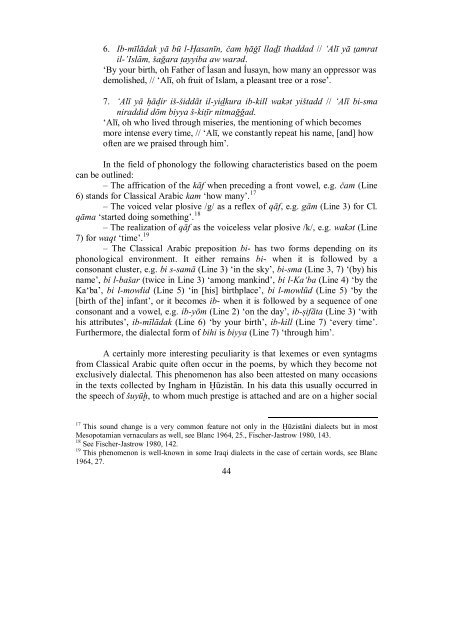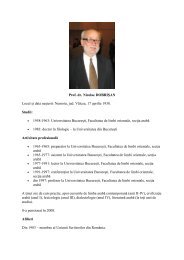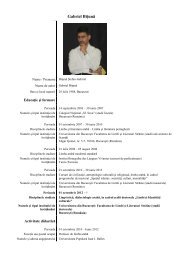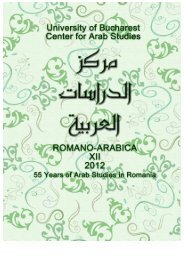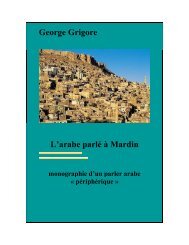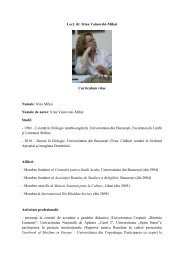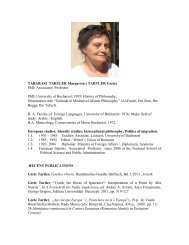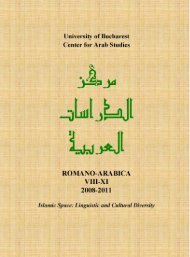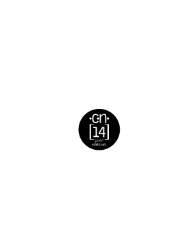University of Bucharest
University of Bucharest
University of Bucharest
Create successful ePaper yourself
Turn your PDF publications into a flip-book with our unique Google optimized e-Paper software.
6. Ib-mīlādak yā bū l-H}asanīn, čam h}āġī lladī thaddad // ‗Alī yā tamrat<br />
il-‘Islām, šağara t}ayyiba aw warəd.<br />
‗By your birth, oh Father <strong>of</strong> Íasan and Íusayn, how many an oppressor was<br />
demolished, // ‗Alī, oh fruit <strong>of</strong> Islam, a pleasant tree or a rose‘.<br />
7. ‗Alī yā h}ād}ir iš-šiddāt il-yidkura ib-kill wakət yištadd // ‗Alī bi-sma<br />
niraddid dōm biyya š-kitīr nitmağğad.<br />
‗Alī, oh who lived through miseries, the mentioning <strong>of</strong> which becomes<br />
more intense every time, // ‗Alī, we constantly repeat his name, [and] how<br />
<strong>of</strong>ten are we praised through him‘.<br />
In the field <strong>of</strong> phonology the following characteristics based on the poem<br />
can be outlined:<br />
– The affrication <strong>of</strong> the kāf when preceding a front vowel, e.g. čam (Line<br />
6) stands for Classical Arabic kam ‗how many‘. 17<br />
– The voiced velar plosive /g/ as a reflex <strong>of</strong> qāf, e.g. gām (Line 3) for Cl.<br />
qāma ‗started doing something‘. 18<br />
– The realization <strong>of</strong> qāf as the voiceless velar plosive /k/, e.g. wakət (Line<br />
7) for waqt ‗time‘. 19<br />
– The Classical Arabic preposition bi- has two forms depending on its<br />
phonological environment. It either remains bi- when it is followed by a<br />
consonant cluster, e.g. bi s-samā (Line 3) ‗in the sky‘, bi-sma (Line 3, 7) ‗(by) his<br />
name‘, bi l-bašar (twice in Line 3) ‗among mankind‘, bi l-Ka‗ba (Line 4) ‗by the<br />
Ka‗ba‘, bi l-mowlid (Line 5) ‗in [his] birthplace‘, bi l-mowlūd (Line 5) ‗by the<br />
[birth <strong>of</strong> the] infant‘, or it becomes ib- when it is followed by a sequence <strong>of</strong> one<br />
consonant and a vowel, e.g. ib-yōm (Line 2) ‗on the day‘, ib-s}ifāta (Line 3) ‗with<br />
his attributes‘, ib-mīlādak (Line 6) ‗by your birth‘, ib-kill (Line 7) ‗every time‘.<br />
Furthermore, the dialectal form <strong>of</strong> bihi is biyya (Line 7) ‗through him‘.<br />
A certainly more interesting peculiarity is that lexemes or even syntagms<br />
from Classical Arabic quite <strong>of</strong>ten occur in the poems, by which they become not<br />
exclusively dialectal. This phenomenon has also been attested on many occasions<br />
in the texts collected by Ingham in H~ūzistān. In his data this usually occurred in<br />
the speech <strong>of</strong> šuyūh~, to whom much prestige is attached and are on a higher social<br />
17 This sound change is a very common feature not only in the H~ūzistāni dialects but in most<br />
Mesopotamian vernaculars as well, see Blanc 1964, 25., Fischer-Jastrow 1980, 143.<br />
18 See Fischer-Jastrow 1980, 142.<br />
19 This phenomenon is well-known in some Iraqi dialects in the case <strong>of</strong> certain words, see Blanc<br />
1964, 27.<br />
44


